List of Contents
Ultralight Aircraft Market Size and Forecast 2024 to 2034
The global ultralight aircraft market size is projected to be worth around USD 25.57 billion by 2034 from USD 10.21 billion in 2024, at a CAGR of 9.62% from 2025 to 2034. The North America ultralight aircraft market size reached USD 3.44 billion in 2023. The growing demand for recreational aviation along with liberal regulatory control and rules around ultralight aircraft has led to growth in the ultralight aircraft market.
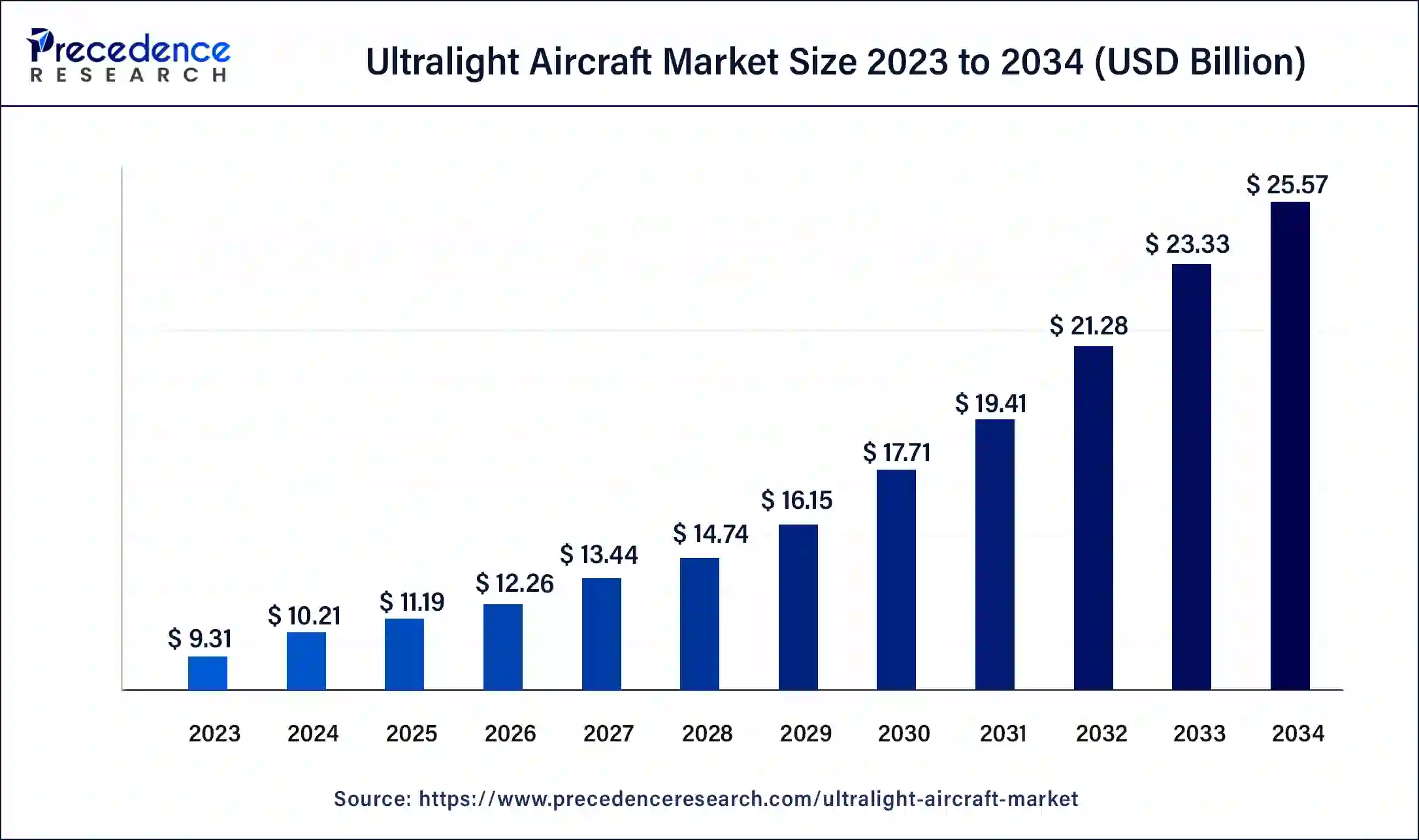
Ultralight Aircraft Market Key Takeaways
- The global ultralight aircraft market was valued at USD 10.21 billion in 2024.
- It is projected to reach USD 25.57 billion by 2034.
- The market is expected to grow at a CAGR of 9.62% from 2025 to 2034.
- North America dominated the ultralight aircraft market with the highest market share of 37% in 2024.
- Asia Pacific is set to host the fastest-growing market during the forecast period.
- By technology, the manned segment has generated more than 68% of market share in 2024.
- By technology, the unmanned segment is expected to grow at the fastest rate in the market during the forecast period of 2024 to 2033.
- By propulsion, the conventional propulsion segment made up the largest share of the market in 2024.
- By propulsion, the electric & hybrid segment is projected to expand rapidly in the market in the coming years.
- By takeoff, the CTOL segment has contributed the highest market share of 73% in 2024.
- By takeoff, the VTOL segment is set to register significant growth in the market during the forecast period.
- By end-use, the civil & commercial segment registered its dominance over the global market in 2024.
- By end-use, the military segment will gain a significant share of the market over the studied period of 2025 to 2034.
U.S. Ultralight Aircraft Market Size and Growth 2024 to 2034
The U.S. ultralight aircraft market size was exhibited at USD 2.83 billion in 2024 and is projected to be worth around USD 7.24 billion by 2034, poised to grow at a CAGR of 9.85% from 2025 to 2034.
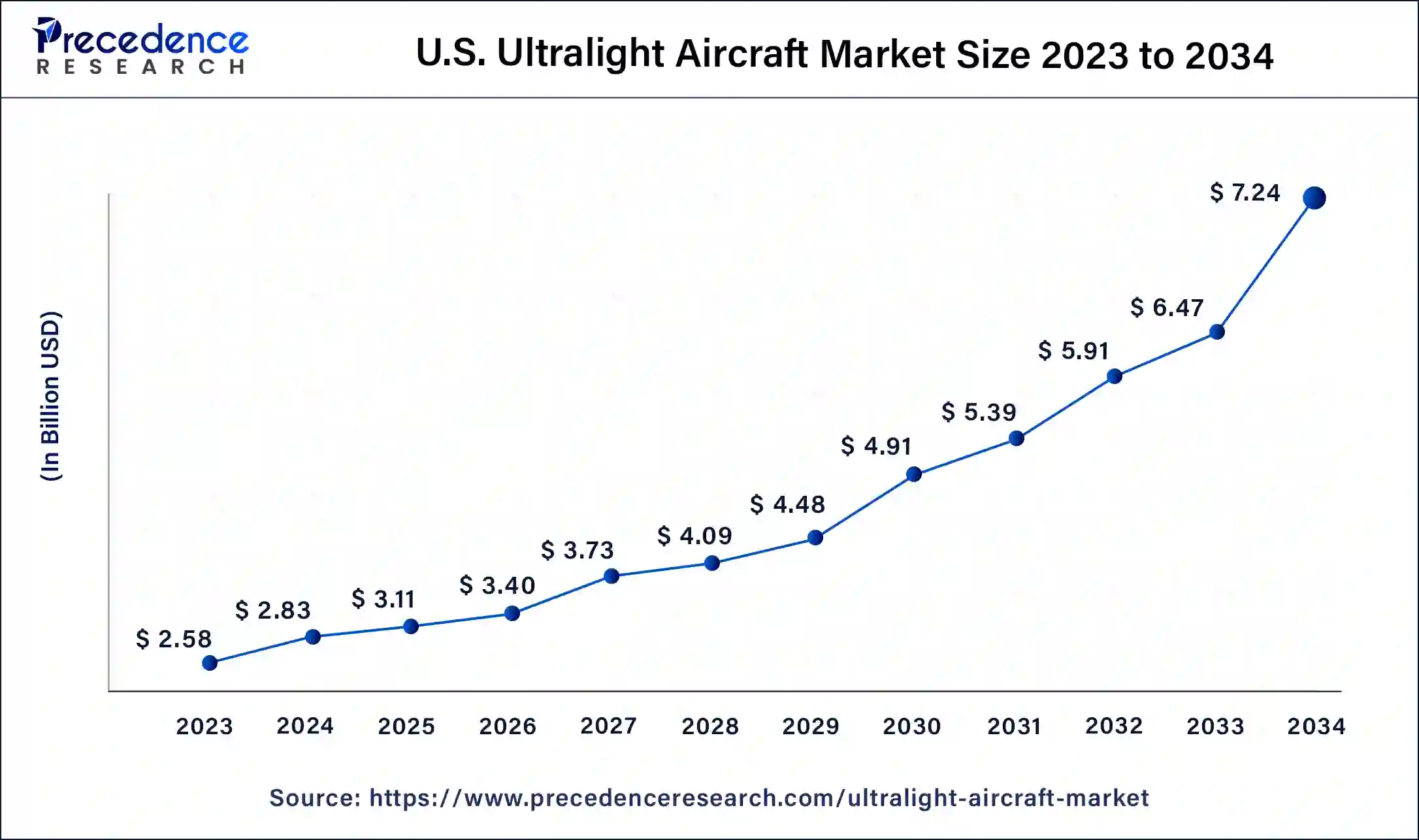
North America dominated the ultralight aircraft market in 2024. The region has liberal regulations when it comes to ultralight aircraft, which has led to their popularity. The United States Federal Aviation Administration leverages very few restrictions on the operation of such planes. These aircraft do not require certifications and are not required to meet the airworthiness certification standards specified for aircraft.
Individuals piloting these crafts are not required to meet any aeronautical knowledge, age, or experience requirements or to have airman or medical certificates, and the vehicles do not need to be registered or carry any registration markings. These lax restrictions, coupled with the growing popularity of recreational aviation in the region, have led to high demand in the market.
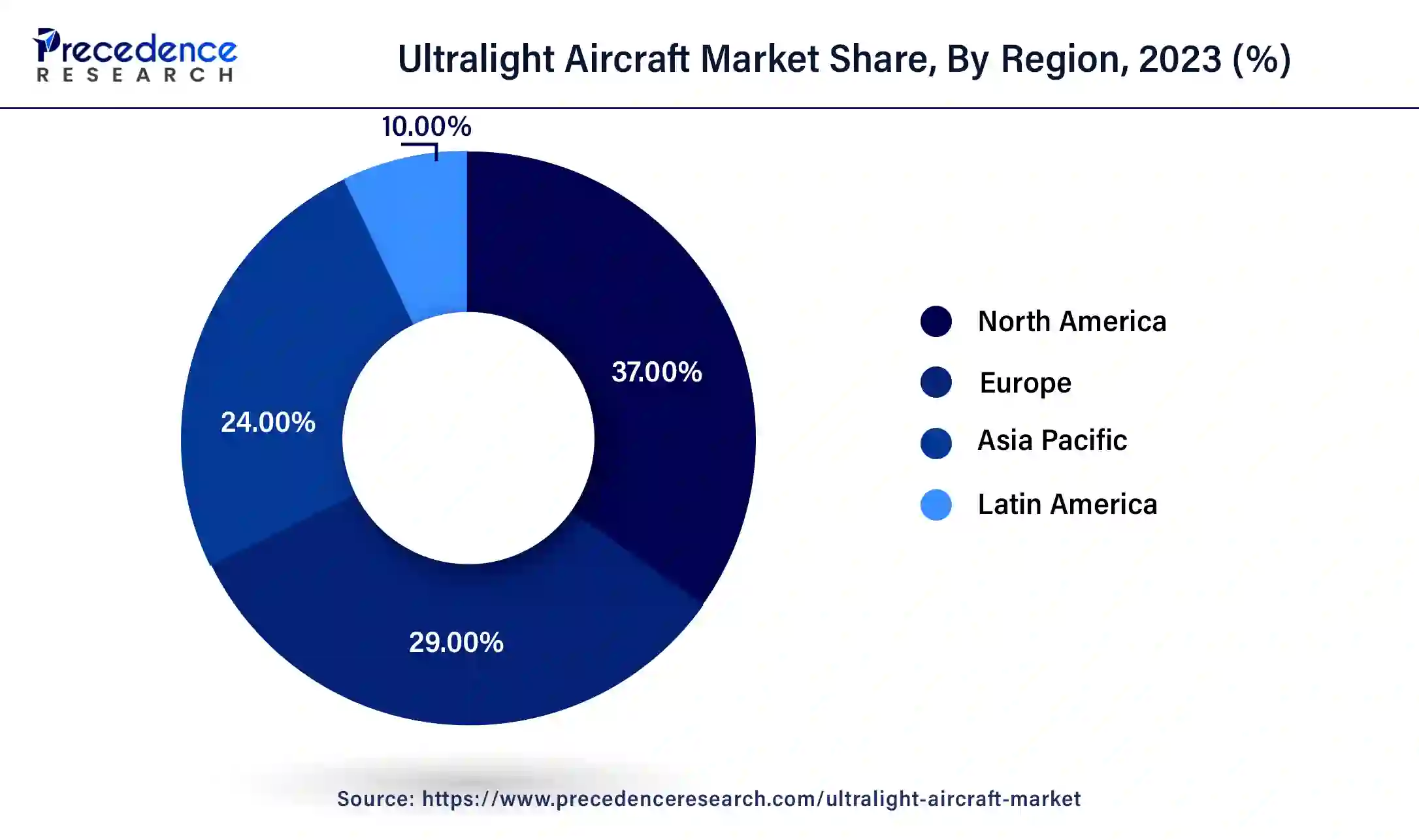
Asia Pacific is set to host the fastest-growing ultralight aircraft market during the forecast period. Countries such as India and China are rapidly developing aircraft infrastructure for tourism, connectivity, and healthcare purposes. China also plans to incorporate short-distance general aviation transportation into the national transportation system by the end of 2025 to meet the needs of air traffic in small and medium-sized cities, as well as remote areas.
- In June 2022, the Civil Aviation Administration of China published the ‘14th Five-Year Plan for General Aviation Development'. The plan set a goal to have 3,500 registered general aviation aircraft and 500 airports in China by the end of 2025.
Market Overview
Ultralight aircraft refers to lightweight airplanes with very low power consumption, which are flown for sports and recreational purposes. However, advanced models are being used for pilot training and patrolling and are being explored in a limited combat role. Ultralight aircraft started as hang gliders modified for power by installing small engines. Newer ultralight aircraft are designed with light, modern materials, such as Nanocomposites, and come equipped with relatively powerful but light engines.
Different aviation bodies across the globe have varied definitions of what is considered an ultralight aircraft and, thus, slightly altered regulatory requirements. Definitions vary according to the maximum permitted weight of the craft, altitude restrictions, and the presence of parachutes. The ultralight aircraft market encompass a wide category of crafts, including lighter-than-air powered airships, powered fixed-wing crafts, powered parachutes, powered and unpowered gliders, and trikes.
Demand in the ultralight aircraft market is driven by high disposable incomes, especially in established economies, and a growing interest in recreational aviation. Technological advances such as innovations in material science and the development of sustainable ultralight aircraft with hybrid and electric power options are opportunities for growth in space. However, high initial costs and disruptions in the global aviation supply chains hinder the market.
How artificial intelligence is transforming the ultralight aircraft market
Artificial intelligence is bringing technological breakthroughs across industries, including aerospace and defense, robotics, metals and mining, navigation, and material fabrication. Nanotechnology has led to the creation of several new lightweight materials that are being adopted into the aerospace industry, including the production of ultralight aircraft. The integration of AI with nanotechnology in the ultralight aircraft market has led to several benefits in material design, the development of new products, and optimization of the fabrication process.
Nanotechnology offers unprecedented precision in fabrication and unique properties to materials, including exceptional strength, electrical conductivity, mechanical and thermal stability, and resistance, making them apt for applications in aerospace engineering. AI-based technologies, such as generative design algorithms, are also used to create innovative and lightweight models for the ultralight aircraft market.
- In October 2023, French vehicle design studio Klissarov Design released a concept design for a recreational electric vertical take-off and landing aircraft. Named Acro, the ultralight eVTOL will use artificial intelligence to assist in its operation and ensure a smooth and safe flying experience.
Ultralight Aircraft Market Growth Factors
- Growing disposable income and a rise in recreational spending in established economies.
- A growing interest in sports and recreational aviation is driving growth in the ultralight aircraft market.
- Lax regulatory policies for ultralight aircraft in several countries are leading to growing adoption.
- In the ultralight aircraft market, development of sustainable aircraft with innovations such as hydrogen-powered cells and hybrid fuel use.
Market Scope
| Report Coverage | Details |
| Market Size by 2034 | USD 25.57 Billion |
| Market Size in 2025 | USD 11.19 Billion |
| Market Size in 2024 | USD 10.21 Billion |
| Market Growth Rate from 2025 to 2034 | CAGR of 9.62% |
| Largest Market | North America |
| Base Year | 2024 |
| Forecast Period | 2025 to 2034 |
| Segments Covered | Technology, Propulsion, Takeoff, End-use, and Regions |
| Regions Covered | North America, Europe, Asia-Pacific, Latin America, and Middle East & Africa |
Market Dynamics
Drivers
Growing income and interest in recreational aviation
Rising disposable income is driving higher leisure spend throughout established economies such as the United States and European countries. Similarly, in the ultralight aircraft market, emerging macro drivers in the leisure economy include valuing experiences above things, widespread use of social media, and expanding free time.
- According to an L.E.K. Consulting article, recreation spending in the U.S. has been on an upward trend, increasing by 24% in the five years leading up to 2017, while U.K. expenditure on leisure activities was up 17% in the five years before 2018 and continues to be on the rise post-pandemic.
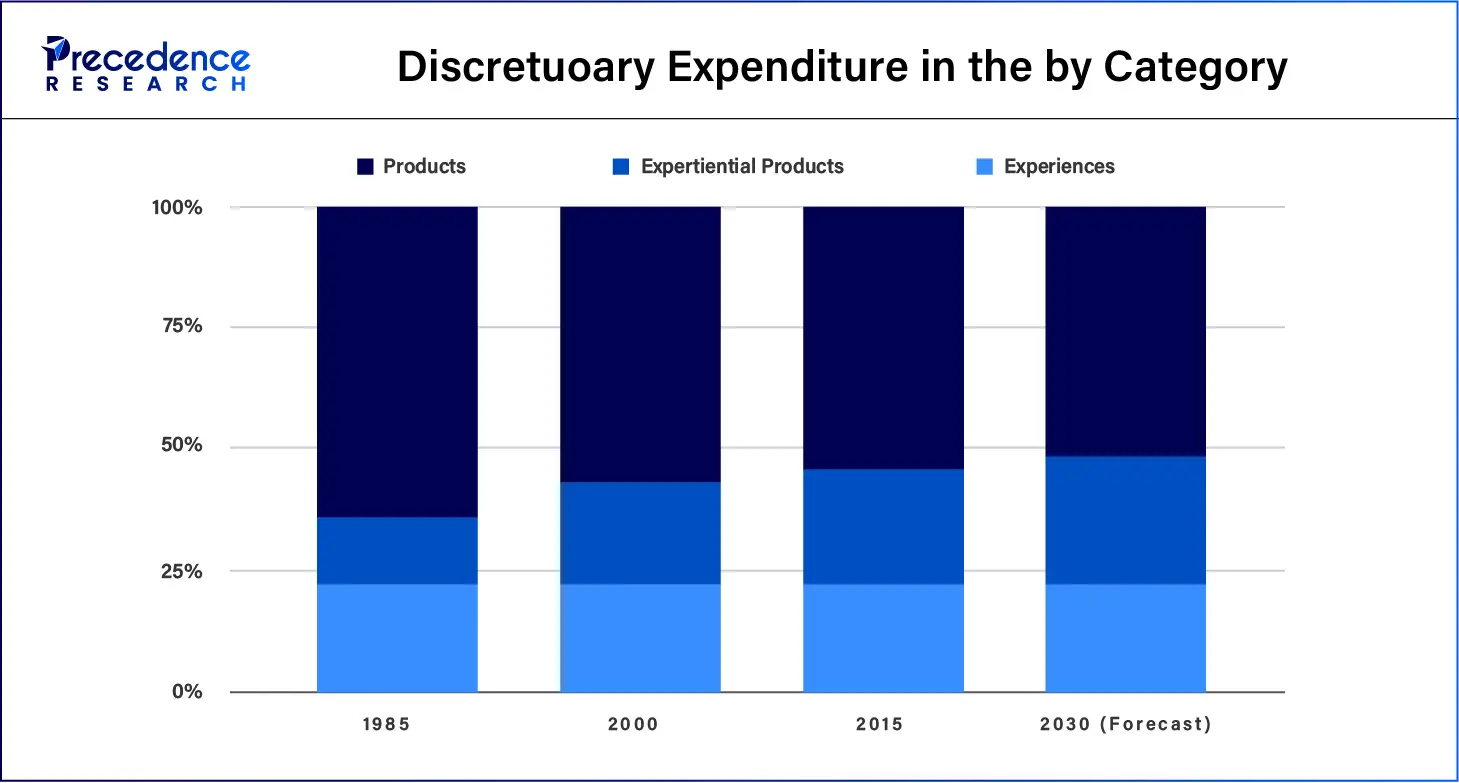
A rise in recreation spending was also reflected in emerging economies such as India and China. According to the International Trade Administration, growth prospects in China remain strong in aviation segments, including short-distance commuting, tourism, leisure and sports, and pilot training. A rise in leisure spending across the world coupled with increased awareness about recreational aviation and access to training has led to consumers increasingly using smaller, personal ultralight and light aircraft in the ultralight aircraft market.
Regulatory support in several countries
The rules and regulations surrounding ultralight aircraft tend to be quite relaxed in several countries, including Australia, the Philippines, the United States, and the United Kingdom. In the United States, one of the biggest ultralight aircraft markets, a user is not required to register their craft, nor is the pilot required to have a pilot's certificate. The United States Federal Aviation Administration has put minimal restrictions on the operation of ultralight aircraft, including limiting flights to the daytime, a maximum of five gallons of fuel, yielding right-of-way to all other aircraft, and restricting flight over controlled airspace.
- In January 2024, U.S.-based eVTOL manufacturer Pivotal opened online sales for their new craft Helix, a personal flying vehicle controlled by a single pilot using a pair of simple joysticks. The craft has an empty weight below 159 kg, qualifying as a Part 103 ultralight aircraft and requiring no FAA pilot certification to fly.
Restraints
High initial costs and safety concerns
In countries with regulations around flying ultralight aircraft, individuals need to invest a substantial amount of time and money in pilot training and obtaining a license. The cost of the ultralight aircraft market products also tends to be prohibitive, with the cheapest options available at an up-front cost of USD 8,000 to USD 15,000. The crafts also need to be maintained regularly, adding further to the price tag.
The high time and monetary cost of engaging in recreational aviation using these crafts poses a restriction on growth in the ultralight aircraft market. In countries where regulations on ultralight aircraft are relaxed and individuals do not require a license or prior training to operate these craft, there are concerns about safety and security.
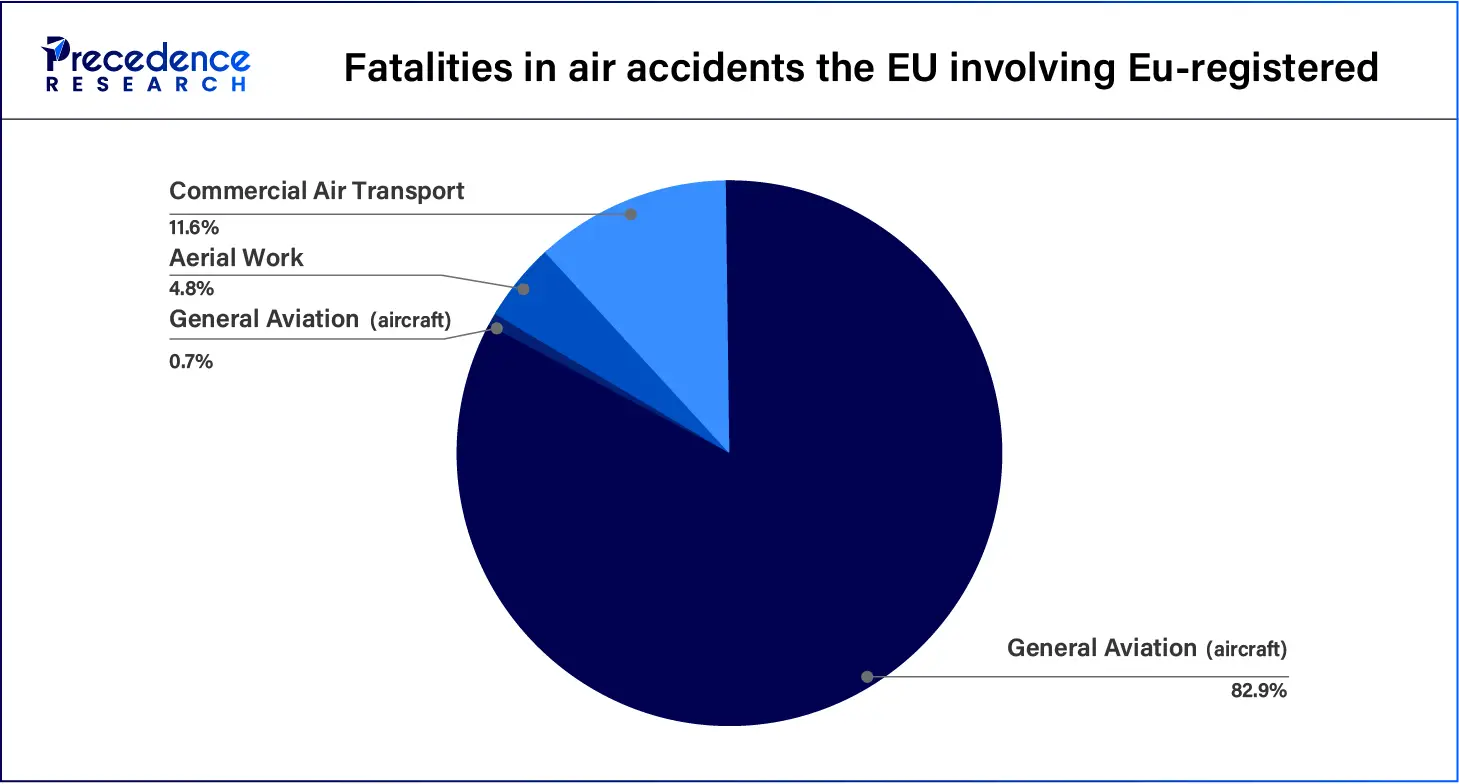
- According to an article in Safety, ultralight accidents are reported to be more severe than those in other sports aviation categories. Other research suggests that, on average, 60 deaths per year occur in the U.S. due to ultralight crashes. Despite a higher number of accidents, the UK had fewer fatal accidents, while the number of destroyed aircraft was significantly higher in Portugal.
- A limited study observed that for the period 2000–2010, 35 accidents occurred in Portugal, 252 in the UK, and 20 in the U.S.
Disruptions in global supply chains
Just as the global aviation industry is recovering from a massive slowdown during the COVID-19 pandemic, supply chain disruptions continue in the sector, and suppliers to aerospace manufacturers face uncertainties with parts suppliers. Major plane producers and original equipment manufacturers, responsible for a sizeable portion of spare parts, decreased their output due to lower demand.
Manufacturers currently do not have enough spare parts to fulfill their existing commitments, so the number ending up in the aftermarket remains limited. Over 85% of the disruptions originated at third-party factories, plants, and warehouses, feeding into the supply chains. Recovery will depend on granting licenses to create more capacity in the system.
Opportunities
Technological developments in terms of materials like nanoparticles
Innovations in aircraft design, propulsion, and manufacturing will drive down the costs of purchasing and operating ultralight aircraft. Technological advancements like the developments in autonomous aircraft improved flight pathing, cloud services, and digital tools would further boost the reliability of these crafts. For instance, increasing the use of precision GPS over traditional instruments and landing systems will allow access to smaller airstrips and airports, increasing the overall accessibility of these crafts. Nanotechnology-based materials like this have the potential to revolutionize the ultralight aircraft market.
- In March 2021, researchers from Helmholtz-Zentrum Geesthacht and Hamburg University of Technology developed a new material design approach: nanometer-sized metal struts that form nested networks on separate hierarchical levels, providing substantial strength while being light. This material has applications in both the aviation and automotive industries.
Rising sustainability via hybrid and electric-power aircraft
The aviation industry is notorious for its high environmental cost, with a 4% share in anthropogenic global warming. Green initiatives and policies across the world look to lower the climate impact of the industry with regulations around fuel use and mandates on emission reductions. The increasing emphasis on sustainable aviation will lead to rising demand in the ultralight aircraft market. Their lightweight design aligns well with reducing fuel emissions and lowering the environmental impact of aviation, attracting environmentally conscious individuals who partake in recreational aviation.
Developments like hydrogen-powered, electric, and hybrid ultralight aircraft are some of the sustainability initiatives in this industry. According to a position paper by Europe Air Sports, fuel consumption for powered flying has improved significantly over the past date, especially in ultralight aircraft (up to two seats).
- In March 2024, French aircraft manufacturer Beyond Aero completed manned test flights in a hydrogen-electric aircraft using a fuel cell. The test flights were conducted on a G1 Aviation two-seater ultralight aircraft retrofitted with Beyond Aero's hydrogen-electric powertrain.
Technology Insights
The manned segment dominated the ultralight aircraft market in 2024. Manned ultralight aircraft have a human pilot controlling the craft. Manned aircraft are most widely used today, especially in ultralight aircraft, where command and control are important and policy restrictions exist. The popularity of manned aircraft is attributed to the demand for recreational flying, pilot training, and some agricultural applications that require human control.
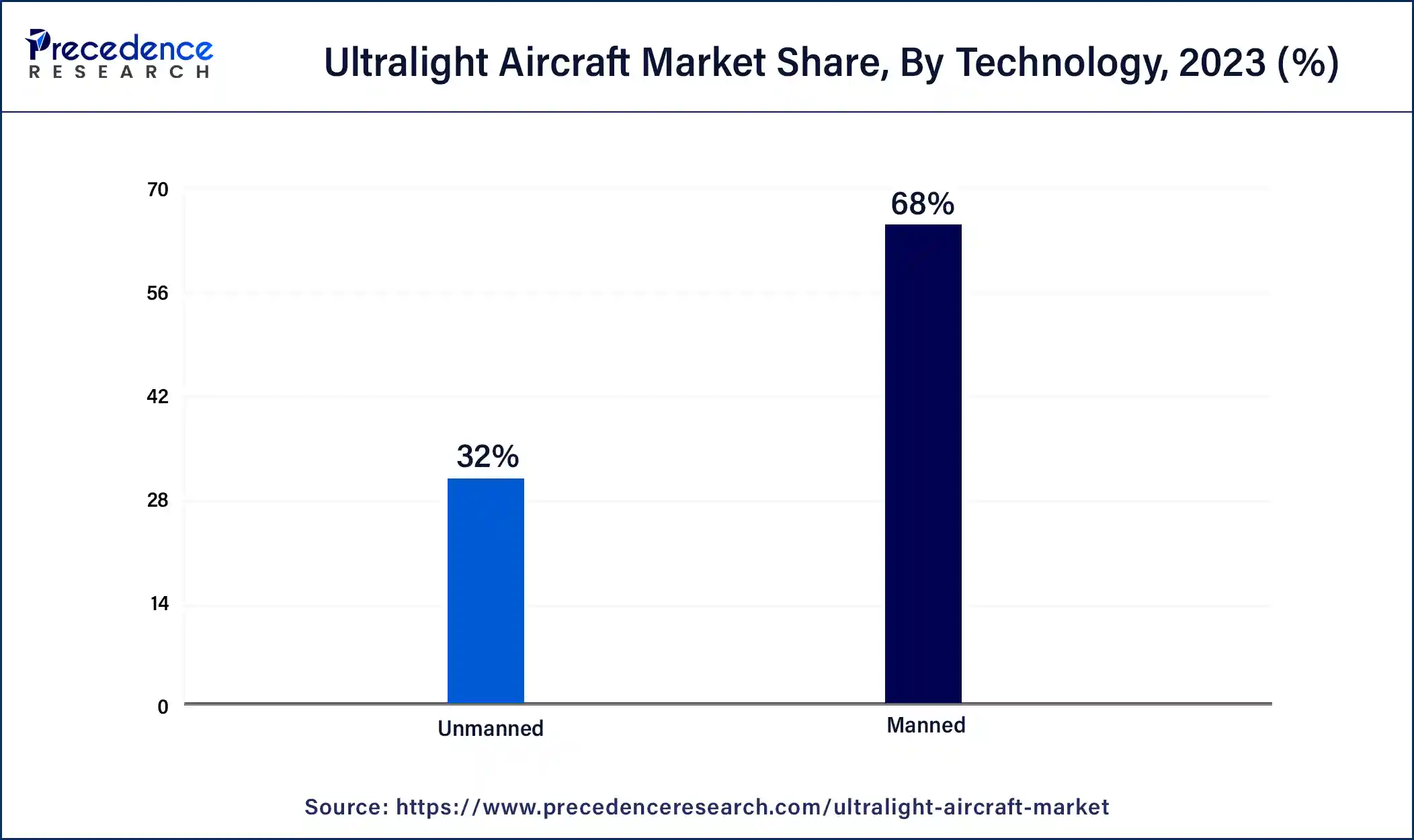
The unmanned segment is expected to grow at the fastest rate in the ultralight aircraft market during the forecast period of 2024 to 2033. Unmanned aircraft have seen significant adoption in agriculture, defense, surveying mapping, and surveillance. Unmanned crafts are popularly used in the military, especially in areas where there is a threat to human safety. Advances in autonomous vehicle technology and AI will likely lead to the advent of fully functional autonomous aircraft in a few years. As of 2024, U.S.-based aerospace manufacturer Wisk Aero has made significant headway towards the first fully autonomous flight with its Generation 6 eVTOL. The company is working towards certification of autonomous aircraft by the end of the decade.
Propulsion Insights
The conventional propulsion segment made up the largest share of the ultralight aircraft market in 2024. Most ultralight aircraft in operation currently use conventional propulsion. Ultralight aircraft tend to have small engines to fit within the weight restrictions in countries of operation. With hybrid and electric engines currently in a nascent stage of development, conventional engines still dominate the ultralight aircraft market.
The electric & hybrid segment is projected to expand rapidly in the ultralight aircraft market in the coming years. Growth in the segment is driven by a demand for environmentally friendly aircraft and technological advances in the development of electric VTOLs and UAVs.
- According to researchers at the Chalmers University of Technology, while the environmental impact of new electric aircraft is higher compared to conventionally propelled ones, after approximately 1,000 flight hours, the electric aircraft overtakes the fossil fuel aircraft in terms of climate impact.
Takeoff Insights
The CTOL segment led the global ultralight aircraft market in 2023. CTOLs are fixed-wing aircraft that need some sort of airstrip or runway to take off. CTOL aircraft are energy efficient, can attain higher altitudes, and cover significant distances compared to their counterparts. These characteristics make CTOLs popular in the market.
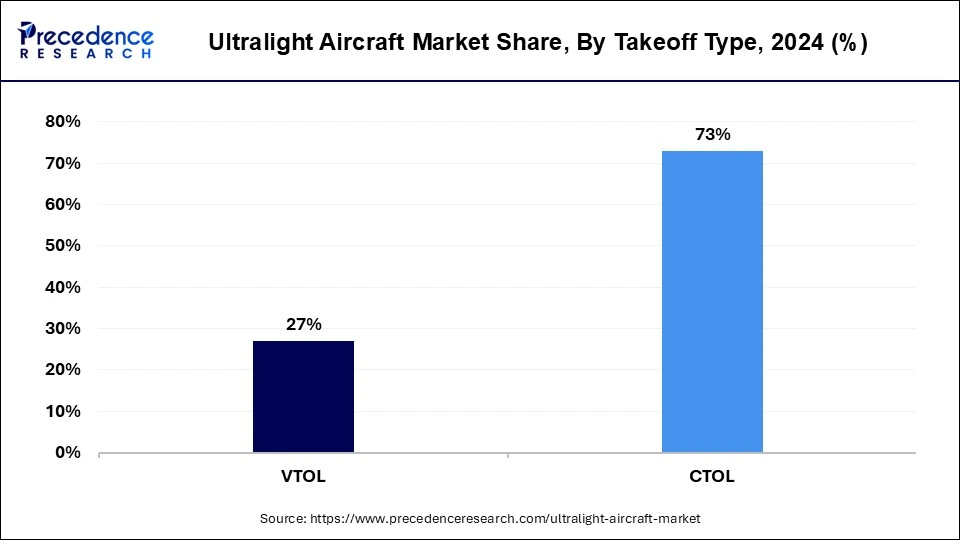
The VTOL segment is set to register significant growth in the ultralight aircraft market during the forecast period. VTOLs are rotary-wing aircraft that do not require runways to take off. They can hover and have high maneuverability. Despite these advantages, their high energy consumption, limited speed, and altitude make them less popular than CTOLs. However, new developments in the eVTOLs segment are propelling growth in the market.
- In October 2023, Swedish startup Jetson's ultralight aircraft Jetson ONE became the first certified ultralight eVTOL allowed to fly all over Italy. In the same month, the company announced that it had obtained two critical flight permits from the Aero Club d'Italia and the Italian Civil Aviation Authority.
End-use Insights
The civil & commercial segment registered its dominance over the global ultralight aircraft market in 2024. Ultralight aircraft have the capacity for one or two people and are used to fly short distances, making them popular for sports and recreational activities. Their characteristics, especially short-flying distances, make them popular in the tourism industry.
The military segment will gain a significant share of the ultralight aircraft market over the studied period of 2023 to 2033. Ultralight aircraft are used in both urban and open warfare in the defense sector. In countries like the United States, the military has been taking an interest in eVTOLs.
- In March 2024, the U.S. Air Force partnered with the eVTOL commercial industry to field a new class of air mobility systems. The AFWERX Agility Prime program aimed to expand the technology in the dual-use transformative vertical lift markets.
Ultralight Aircraft Market Companies
- Cirrus Aircraft
- P&M Aviation
- Textron Inc.
- Pipistrel
- Pilatus Aircraft Ltd.
- VOLOCOPTER GMBH
- Legend Aero
- AutoGyro
- Evektor
- Vulcanair
- Helix
- Jetson
- Wisk Aero
- Beyond Aero
Recent Developments
- In July 2024, during the annual EAA AirVenture Oshkosh held in the United States, eight new ultralights, gyroplanes, and experimental aircraft were announced, including the CGS Hawk Ultra, Pivotal Helix, Calidus Gyroplane, TrueLite, and MXL 2 Sport.
- In April 2024, Germany-based GmbH, a leading manufacturer of ultralight aircraft, is set to produce ultralight CT series aircraft in Kazakhstan. The project was announced at the 30th AERO Friedrichshafen General Aviation Exhibition in Germany during the Flight Design and Kazakh Invest press conference.
Segments Covered in the Report
By Technology
- Manned
- Unmanned
By Propulsion
- Conventional Propulsion
- Electric & Hybrid
By Takeoff
- CTOL
- VTOL
By End-use
- Civil and Commercial
- Military
By Geography
- North America
- Asia Pacific
- Europe
- Latin America
- Middle East & Africa
For inquiries regarding discounts, bulk purchases, or customization requests, please contact us at sales@precedenceresearch.com
Frequently Asked Questions
Ask For Sample
No cookie-cutter, only authentic analysis – take the 1st step to become a Precedence Research client